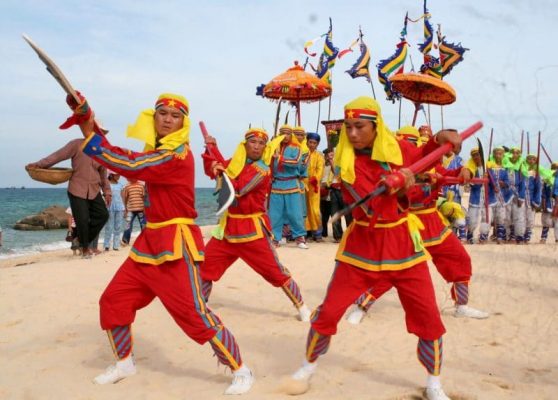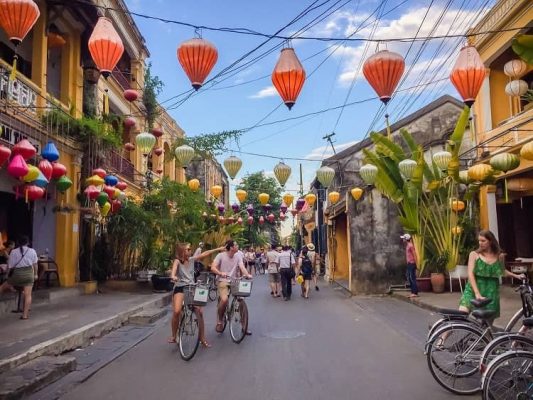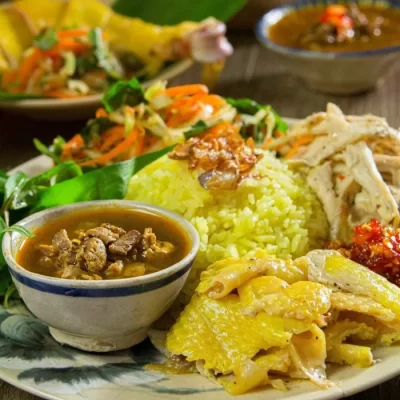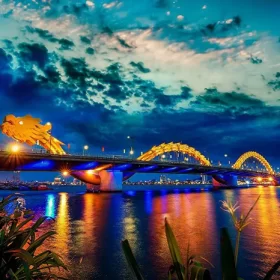
Hoi An’s ancient town
Hoi An is a place where the seemingly indifferent flow of time cannot bury the ancient atmosphere. The old tiled roofs covered in moss, the streets immersed in the red glow of lanterns, and the delicately crafted ornamental motifs all transport us back to a world of centuries past. This is just a glimpse of the charm of Hoi An Ancient Town, enough to captivate and make one forget their way. The Introduction to Hoi An’s Old Town article provides a clearer insight into Hoi An. Follow Ula Travel now!
I. LOCATION OF HOI AN

Location map of Hoi An
Hoi An’s Old Town is an ancient town located on the lower reaches of the Thu Bon River in the coastal plain of Quang Nam Province, Vietnam, about 30 km south of Da Nang city.
Hoi An is a city in Quang Nam Province with many ancient streets built since the 16th century and still almost intact to this day. In Western documents, Hoi An is referred to as Faifo. Hoi An’s Old Town has been recognized as a UNESCO World Heritage Site since 1999. It is a destination that attracts many tourists from Da Nang to Hoi An.
II. HOW TO GET TO HOI AN
How do you get to Hoi An? Let’s reveal some travel tips for Hoi An:
- By plane: From Hanoi or Ho Chi Minh City, you can easily book a flight to Da Nang. After arriving in Da Nang, you can take a taxi, bus, or book a shuttle service from Da Nang Airport to Hoi An.
- By train: From Hanoi or Ho Chi Minh City, you can take a train to Hoi An, stopping at Tra Kieu Station (Quang Nam) or Da Nang Station, depending on your itinerary.
- By bus: There are many bus routes from Hanoi to Hoi An and from Ho Chi Minh City to Hoi An. You can go to major bus stations to buy tickets.
- By motorbike or car: Exploring Hoi An on your own with a motorbike or car is very interesting. Make sure to carefully research the route before starting your journey.
III. HOI AN PEOPLE
Similar to the ancient houses, the Hoi An people are elegant, warm, and sophisticated yet unpretentious. Particularly upon meeting them for the first time, one feels a sense of familiarity, as if they’ve known each other for a long time. Although most families run businesses and engage in daily trading activities as in ancient times, tourists are truly amazed by their sincere, honest, and culturally rich behavior, a culture not learned from books but ingrained in tradition.
When visiting any shop in Hoi An, you can browse, inquire about prices, and bargain comfortably. After about half an hour, if you haven’t chosen anything, you can step out of the store, yet you’ll still receive friendly smiles as if saying, “It’s a pity you didn’t find anything this time; please come back again.” Their simple yet profound outlook on life and their sincere demeanor are truly remarkable. The perspective of the Hoi An people is simple yet profound. They take pride in and cherish the heritage of their ancestors.
On one hand, they take care to preserve, renovate, and honor the old town to ensure its existence until today, recognized by the world as a cultural heritage site. On the other hand, they maintain their way of life, embodying the gentle and hospitable character of the Hoi An people. This has made Hoi An a place to remember and cherish, whether one visits or stays.
IV. HOI AN CULTURE
1. Architectural Relics

Ancient architecture relics
As the only remaining traditional Southeast Asian port town in Vietnam, rare in the world, Hoi An preserves over a thousand architectural relics such as streets, houses, assembly halls, temples, pagodas, shrines, clan houses, ancient wells, and tombs.
Here, tourists have the opportunity to admire architecture that showcases both the traditional artistic nuances of Vietnam and the cultural exchanges with Eastern and Western countries.
2. Cultural Festivals
In addition to the cultural values through diverse architecture, Hoi An also preserves many intangible cultural activities, with cultural festivals being preserved and promoted alongside traditional handicraft villages, making this ancient city an increasingly attractive destination for tourists from all over.
Long Chu Festival held on the 15th day of the first lunar month and the 15th day of the seventh lunar month every year. On the main festival day, the entire village parades Long Chu (a dragon-shaped boat) to the communal house, where the owner and the sorcerer will open the dragon’s eyes. After many ritual offerings, in the evening, the boatmen will take Long Chu to places in need, burn it, and release the ashes into the sea.

Boat Racing Festival
Boat Racing Festival usually held during the Tet holiday from the 2nd to the 7th day of the first lunar month. Boat racing is an occasion to please the gods who have protected the village.

Fish Worship Festival
Fish Worship Festival typically organized on the 2nd day of the second lunar month. During the fish worship festival, the people of Hoi An’s fishing villages also hold ceremonies to worship Ca Ong (the Whale), expressing gratitude to Ca Ong for helping people in distress at sea.

Full Moon Night Festival in the Old Town
Full Moon Night Festival in the Old Town held every 14th night of the lunar month. During the festival, all houses and shops turn off their lights, giving way to the moonlight and lanterns. On the streets, people participate in folk games, play chess, gamble, or take boat trips on the Hoai River and release lanterns.
3. Folk Music and Traditional Games

Bai choi singing
When it comes to Hoi An’s culture, one cannot overlook folk music, traditional games, and religious customs. The forms of performance and traditional games here crystallize from the local people’s labor processes and are still fully preserved. These include rhythmic chants, folk games like tug of war, spinning tops, or various forms of traditional music and performances such as tuong singing, bai choi, or gambling chants.
4. In terms of Religious Culture
The people of Hoi An worship their ancestral spirits alongside the Five House Spirits (the guardian spirits of the house). Regarding religion, various religions coexist in Hoi An, such as Buddhism, Caodaism, Protestantism, and Roman Catholicism, with Buddhism still playing a dominant role.
5. Culinary Culture
In the 17th and 18th centuries, Hoi An was a bustling international trading port. This place was a trading hub for Vietnamese, Chinese, Japanese, and Westerners. Therefore, Hoi An’s culinary culture is extremely rich, diverse, and characteristic of many regions worldwide. Visitors will have the opportunity to enjoy many unique and delicious dishes. Not only are the eateries in Hoi An remembered for their delicious food, but they also captivate tourists with their beautiful decorations, professional service, and unique atmosphere.
Restaurants in the old town often hang old paintings and surround themselves with flower pots, ornamental trees, and handicrafts. The eateries also bear traditional names inherited from many generations.
V. BEST TIME TO VISIT HOI AN
The climate in Hoi An, as well as the central provinces in general, can be considered quite harsh. Hoi An does not have the typical four-season weather of spring, summer, autumn, and winter but rather distinct seasons: the rainy season and the dry season, each lasting about half a year.
1. Dry Season
Starting from February to August is the dry season, or it may begin in January and end in July, depending on the year, as the dry season may vary. According to independent travel experiences in Hoi An, this is the ideal time to explore the ancient town. With an average temperature of 33 degrees Celsius, it’s very conducive for tourists to visit. Some months have almost no rain, with continuous sunshine from early morning until late evening.
However, if you don’t like intense sunlight like that of the central region, you can choose the early or late dry season when the weather is more pleasant.
Advantages of traveling during the dry season include:
- Sunny weather with little rain, which is very convenient for sightseeing and getting around.
- Ideal for diving to admire coral reefs in Cu Lao Cham.
- Diverse entertainment, dining, and recreational services with many choices.
- A high influx of tourists; extremely bustling and lively.
- There are many special events and festivals after the Lunar New Year that are very unique and attractive.
- Very suitable for taking Instagram-worthy photos and capturing beautiful memories.
Traveling during the dry season offers many exciting experiences that you shouldn’t miss, such as:

Boat rides on the Hoai River
- Boat rides on the Hoai River: An experience you cannot miss when visiting during the dry season is taking a boat ride on the Hoai River in the evening. Sitting on a boat along the river, you can admire the panoramic view of Hoi An sparkling in lantern light and release lanterns to pray for peace for your family and yourself.

Adventures in Cycling
- Biking to explore the ancient town: A characteristic of Hoi An’s ancient town in the dry season is the vibrant paper flower racks blooming with colors. Choosing to stroll or bike around the narrow alleys and corners of the ancient town will allow you to both admire the ancient beauty and learn more about Hoi An.

Beach bathing and checking in at An Bang Beach
- Beach bathing and checking in at An Bang Beach: swimming or enjoying beach activities is definitely an essential experience when traveling to Hoi An during the dry season. You can go sunbathing, swim, participate in various beach entertainment activities, and capture beautiful photos to preserve memories of your trip.
2. Rainy Season
The rainy season lasts from August to February of the following year. The rainy season, also known as the low season, sees fewer visitors due to the rain. However, this is also the ideal time for those who want to experience the quiet, serene, and ancient beauty of the old town.
However, if you’re unsure about when to travel to Hoi An, which month, or checking the weather conditions before you go, it’s easy to encounter rain, which can make sightseeing difficult.
Advantages of traveling to Hoi An during the rainy season include:
- Hoi An in the rainy season exudes a poetic, romantic beauty suitable for those who want to explore the old town in a special way.
- The rainy season is always calm, gentle, and not as crowded as the dry season, so sightseeing feels very comfortable and relaxed without the hustle and bustle.
- If you travel during the rainy season, you will save quite a bit of money for your trip because during this time, services such as airfares and hotels often reduce prices or offer attractive promotions.
- Visiting ancient town during this time will give you the opportunity to fully admire the old town submerged in floodwater. Hoi An then has a very different, rarely seen beauty, surely an unforgettable memory.
Visiting during the rainy season brings a very tranquil, serene beauty that will bring you many new and interesting experiences, such as:

Chilling at Hoi An’s cafes
- Chilling at Hoi An’s cafes: You can sit in a café with a view of the sky or the street to feel the rainy-day atmosphere of Hoi An. Enjoying a hot cup of coffee with soft music playing in the background while watching the rain outside will give you a feeling of relaxation and peace.
- Checking in at the peaceful alleys: The famous ancient town has many unique small alleys; you can walk and take photos in Hoi An’s alleys during the rainy season. Everything in the drizzle has a serene, quiet beauty, helping you capture beautiful, romantic photos.

Hoi An chicken rice
- Enjoying Hoi An’s specialties: Planning a food tour of Hoi An during the rainy season is also an interesting idea. Hoi An has many famous dishes loved by domestic and foreign tourists. You can explore and enjoy delicious, enticing dishes without having to wait too long, as during the peak tourist season.
- Visiting ancient houses: learning about the history and culture of Hoi An through the ancient houses is also a great experience for you. The cool weather and the slightly musty air will help you clearly feel the ancient, traditional nature of the houses here.
VI. ATTRACTIVE DESTINATIONS IN HOI AN
1. Japanese Covered Bridge

Japanese Covered Bridge
Dubbed the soul and the symbol of Hoi An, the Japanese Covered Bridge, built by the Japanese in the late 16th century, stands as a testament to the harmonious blend of Vietnamese, Japanese, and Chinese architectural styles, spanning a small stream with its exquisite and unique design.
2. Hoai River

Hoai River
Next to the Japanese Covered Bridge, the image of the Hoai River is familiar to every visitor to Hoi An. Serene and peaceful, the Hoai River flows gently through the heart of the city, mirroring the laid-back lifestyle of the locals.
3. Lantern Street

Lantern Street
Multicolored lanterns illuminating a corner of the sky have become an iconic image of the ancient town every evening. Visitors can enjoy the beauty of lanterns hanging everywhere, regardless of the time they visit.
4. Phung Hung Ancient House

Phung Hung Ancient House
This ancient house showcases a blend of Japanese, Chinese, and Vietnamese architectural styles. Built in the late 18th and early 20th centuries, Phung Hung Ancient House has retained its original charm for over two centuries.
5. Tan Ky Ancient House

Tan Ky Ancient House
With a history spanning over 200 years, Tan Ky Ancient House has been classified as a national historical site. This house boasts a unique architectural fusion of Japanese, Chinese, and Vietnamese influences.
6. Phuc Kien Assembly Hall

Phuc Kien Assembly Hall
One of the most visited tourist spots in Hoi An, the Phuc Kien Assembly Hall was built in 1967 to pray for health, favorable weather, and prosperity for offspring.
7. Trieu Chau Assembly Hall

Trieu Chau Assembly Hall
For culture enthusiasts, the Trieu Chau Assembly Hall is an ideal destination. Also known as the Am Bon Pagoda, it serves not only as a place of worship but also as a gathering point for the Trieu Chau community in Hoi An.
8. Hoi An Market
Hoi An Market is not only a place for sightseeing but also for tasting a wide variety of local specialties and indulging in photography. Unlike the peaceful atmosphere of the ancient town, Hoi An Market is bustling and lively, offering countless dishes such as Cao Lau, Mi Quang, sweet soup, and various souvenirs. Don’t forget to capture the super chill vibe at the market entrance!
9. Ba Mu Temple

Ba Mu Temple
Known as the “virtual living” sanctuary, Ba Mu Temple is constantly buzzing with young people eager to check-in. With its intricately adorned golden walls and a crystal-clear pond reflecting the deep blue sky, it provides a perfect backdrop for photos.
10. An Bang Beach

An Bang Beach
Apart from its heritage sites, Hoi An also boasts beautiful beaches, with An Bang Beach being one of them. Just 3km from the city center, An Bang Beach has made it to the list of the world’s top 50 beaches.
11. Cua Dai Beach

Cua Dai Beach
Another famous and beautiful beach in Hoi An is Cua Dai Beach, a must-visit destination for those exploring the heritage region.
12. Bay Mau Coconut Forest

Bay Mau Coconut Forest
Located about 3km from the city center, this tourist spot in Hoi An is dubbed the “Mekong Delta in the heart of the ancient town.” Visitors to Bay Mau Coconut Forest can experience various water-based activities.
13. Thanh Ha Pottery Village

Thanh Ha Pottery Village
If you’re wondering where to go and what to do in Hoi An, make sure to visit Thanh Ha Pottery Village. Situated along the Thu Bon River, about 3km from the ancient town, this village has preserved the traditional pottery craft for over 500 years.
























